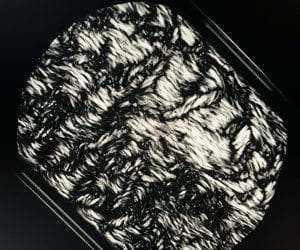Kaitlin Oh

Which grant that you received do you want to talk about?
Summer URG
Please provide a brief summary of your research.
My research this summer focused on determining whether mixtures of peptide amphiphiles (PAs) with the peptide sequences A2G2 and V2A2 would result in molecularly mixed or phase-separated (non-mixing) supramolecular nanofiber assemblies. To test this, I utilized variable temperature polarized light microscopy (VT-PLM) to record the temperature at which PA fiber assemblies transitioned into spherical micelles. This transition temperature was denoted by the complete loss of birefringence signal, produced by anisotropic nanofiber assemblies, indicating a complete transition to isotropic spherical micelles.
Based on previous work, the A2G2 peptide sequence is known to form weak β-sheets that produce less cohesive nanofibers, leading to lower transition temperatures. In contrast, the V2A2 sequence is known to form strong β-sheets and more cohesive nanofibers, resulting in higher transition temperatures. Thus, increases in mol % composition of A2G2-based PAs mixed with V2A2-based PAs were expected to decrease cohesion within fiber nanostructures and therefore decrease the transition temperature. This trend was seen in my past work on mixtures of A2G2E2 with V2A2E2 PAs and A2G2E4-GIKVAV with V2A2E4-GIKVAV PAs, which indicated some degree of mixing between the PA pairs.
I chose to further analyze this trend by altering the equivalents of NaOH added to PA mixtures of the A2G2E4-GIKVAV with V2A2E4-GIKVAV PAs, which were originally prepared with 4 equivalents of NaOH. This mixture was selected in particular to better analyze the effect of epitopes like GIKVAV on the mixing of PAs. As greater equivalents of NaOH tend to reduce cohesion within a fiber assembly and therefore reduce the transition temperature, I was curious to see if the same transition temperature trend would persist in mixtures of 3 and 3.5 equivalents of NaOH as well. Under VT-PLM, the same trend in transition temperature was observed for all equivalents of NaOH, noted by a more rapid decrease in birefringence signal intensity with increasing % A2G2E4-GIKVAV. In addition, for the 30% and 50% A2G2E4-GIKVAV samples at all NaOH equivalents, there appeared to be multiple inflection points along the heating profiles; however, these inflections became less distinct with greater equivalents of NaOH. These inflection points suggested that there was a two-phase mixture at intermediate compositions of the two PAs, i.e., the appearance of a miscibility gap at lower equivalents of NaOH. Therefore, this further confirmed that rather than PA mixtures forming either fully phase-separated or completely molecularly mixed fiber assemblies, there seemed to be an upper limit on the degree of mixing between the different PAs.
To add a little context for the photos – this is a photo of the birefringence signal detected from various fiber assembly mixtures of peptide amphiphiles under a polarized light microscope (PLM).
What made you initially interested in researching your project in particular?
When I first looked into doing research, I came across the Stupp lab group’s 2021 Science paper on spinal cord regeneration utilizing peptide amphiphile assemblies. I was almost immediately sold on wanting to learn more about peptide amphiphiles and how they could be manipulated to perform such amazing feats in medicine. With my project, I had the opportunity to not only look into the mechanisms involving mixtures of peptide amphiphiles but specifically those containing one of the two epitope sequences used in the spinal cord regeneration study. Suffice to say, my project entailed an amazing and fascinating first experience in research.
What made you interested in pursuing (interdisciplinary) research more broadly?
I had never done research in the past, so I was quite curious to see what it would entail. I also have a passion for chemistry, and I was always interested in conducting some kind of lab work in the future.
Describe your experiences with research thus far. Was it tricky? What skills do you think you’ve gained?
I am really glad that I had the opportunity to conduct research in such a wonderful lab group! I learned a lot about how important and helpful working with other researchers can be for fostering new ideas for a project. I often had to present my research at subgroup meetings, and the feedback that I received from other lab members helped a lot to both answer some of the questions that came up in my project as well as provide new approaches to answering my research question. These subgroup meetings also allowed me to develop my communication and presentation skills to best explain my findings to a more unfamiliar audience. I also worked on a paper describing some of my discoveries, which allowed me to practice reading scientific papers as well as better understand my own project overall.
I would say the trickiest part about my research was making sure to keep a detailed record of my previous data and samples. Throughout the course of my project, I had made a ton of samples of various buffer solutions and peptide amphiphiles that had been used in different experiments at different times. Thus, I learned to take very thorough notes during my sample prep and data collection to make my experiments more easily reproducible.
Any tips or advice you have for students similar to you that are interested in pursuing undergraduate research?
Definitely do it! It can be a very rewarding as well as eye-opening experience into different fields of work that not many people get to witness first-hand or even be a part of. I think research is also a great way to see how what you learn in classes gets applied to real world issues/questions.
What would you name a boat if you had one?
Larry
What was your favorite childhood story (written, spoken, or film)?
Dr. Seuss’s The Lorax
What was a memorable interaction that you had on campus this week?
Said “Hi” to my former organic chemistry lab TA and he remembered me 🙂
